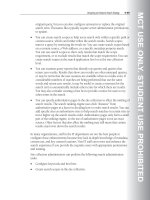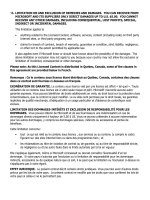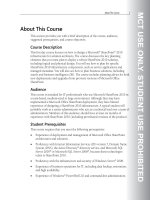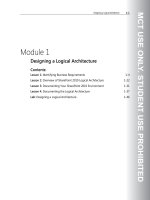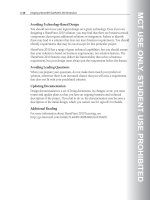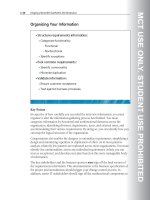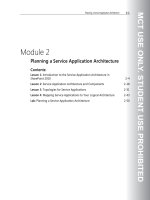Designing a Microsoft SharePoint 2010 Infrastructure Vol 1 part 3 ppsx
Bạn đang xem bản rút gọn của tài liệu. Xem và tải ngay bản đầy đủ của tài liệu tại đây (134.96 KB, 10 trang )
MCT USE ONLY. STUDENT USE PROHIBITED
About This Course i
About This Course
This section provides you with a brief description of the course, audience,
suggested prerequisites, and course objectives.
Course Description
This five-day course focuses on how to design a Microsoft® SharePoint® 2010
infrastructure for solution architects. The course discusses the key planning
elements that you must plan to deploy a robust SharePoint 2010 solution,
including logical and physical design. You will see how to plan for specific
SharePoint 2010 infrastructure components, such as service applications and
managed metadata. You will also see how to plan business solutions, including
search and business intelligence (BI). The course includes planning advice for both
new deployments and upgrades from previous versions of Microsoft Office
SharePoint.
Audience
This course is intended for IT professionals who use Microsoft SharePoint 2010 in
a team-based, medium-sized to large environment. Although they may have
implemented a Microsoft Office SharePoint deployment, they have limited
experience of designing a SharePoint 2010 infrastructure. A typical student will
probably work as a senior administrator who acts as a technical lead over a team of
administrators. Members of this audience should have at least six months of
experience with SharePoint 2010 (including prereleased versions of the product).
Student Prerequisites
This course requires that you meet the following prerequisites:
• Experience of deployment and management of Microsoft Office SharePoint
architectures and solutions.
• Proficiency with Internet Information Services (IIS) version 7, Domain Name
System (DNS), the Active Directory® directory service, and Microsoft SQL
Server 2005® or Microsoft SQL Server 2008®, because these technologies
relate to SharePoint 2010.
• Proficiency with the infrastructure and security of Windows Server® 2008.
• Experience of business operations for IT, including data backup, restoration,
and high availability.
• Experience of Windows® PowerShell 2.0 and command-line administration.
MCT USE ONLY. STUDENT USE PROHIBITED
ii About This Course
• Experience of server availability and performance concepts (SQL Server
mirroring and load balancing).
• A good understanding of security concepts and authentication methods,
including least privilege, as they relate to Microsoft Office SharePoint.
• An understanding of Internet Security and Acceleration (ISA) Server and
Microsoft Forefront™ Unified Access Gateway (UAG).
• Experience of designing for high availability and disaster recovery.
• A conceptual understanding of BI, search, and the use of metadata.
Course Objectives
After completing this course, students will be able to:
• Describe the core methods for identifying business requirements and how
these affect logical architecture planning for a SharePoint 2010 deployment.
• Describe how to plan the service application architecture in SharePoint 2010.
• Describe the principles of designing to maximize performance and capacity in
a SharePoint 2010 deployment.
• Describe how to successfully plan the physical components of a SharePoint
2010 deployment.
• Describe the security architecture of SharePoint 2010 and the importance of
creating a design that is based on the principle of least privilege.
• Explain how to select authentication methods in a SharePoint 2010 design.
• Describe how to match the managed metadata architecture in SharePoint 2010
to business requirements.
• Describe how to plan a social computing implementation of SharePoint 2010
that meets business requirements.
• Describe the architecture and topologies that are available to service a range of
search requirements across business models.
• Describe the core functionality of Enterprise Content Management (ECM) in
SharePoint 2010 and how it influences solution design.
• Describe core BI principles that will affect planning for SharePoint 2010.
• Describe how to plan for data governance in SharePoint 2010.
MCT USE ONLY. STUDENT USE PROHIBITED
About This Course iii
• Describe the considerations for developing a maintenance and monitoring
plan for SharePoint 2010 that also incorporates the technologies that support
SharePoint 2010.
• Describe how to develop a business continuity plan for SharePoint 2010.
• Describe the available options and their benefits when you plan a Microsoft
Office SharePoint upgrade to SharePoint 2010.
Course Outline
This section provides an outline of the course:
Module 1, “Designing a Logical Architecture,” describes the function, components,
and creation of a logical design and explains why this design is the first stage in
any SharePoint 2010 solution.
Module 2, “Planning a Service Application Architecture,” describes the new service
application architecture in SharePoint 2010 and explains how you should plan to
deploy services across a range of farm topologies.
Module 3, “Planning for Performance and Capacity,” explains the importance of
performance and capacity planning in SharePoint 2010. It also describes how to
design a robust and high-performance deployment.
Module 4, “Designing a Physical Architecture,” describes the key components of
the physical architecture in SharePoint 2010, such as processor, memory, disk, and
network access. It reviews how best to design a hardware and software
infrastructure for each of the server types that you can deploy in a SharePoint farm.
Module 5, “Designing a Security Plan,” describes the security architecture of
SharePoint 2010 and the considerations that you must include in your security
planning. These considerations include management of security accounts,
management of users and groups, and the reasons why you should implement
secure transport protocols.
Module 6, “Planning Authentication,” discusses the available authentication
options for SharePoint 2010 and describes how to plan for these in the new,
claims-based security architecture.
Module 7, “Planning Managed Metadata,” describes the function of managed
metadata and explains how you can best use the Managed Metadata Service to
deliver business benefits.
Module 8, “Planning Social Computing,” explains how SharePoint 2010 can
deliver social computing services to an organization. It focuses particularly on the
MCT USE ONLY. STUDENT USE PROHIBITED
iv About This Course
planning that you require to deploy the User Profile Service to maximize social
computing benefits.
Module 9, “Designing an Enterprise Search Strategy,” describes the architectures
and topologies that are available when you plan to deploy enterprise search in your
organization. This includes discussions about both SharePoint 2010 search and
Microsoft FAST™ Search Server 2010 for SharePoint.
Module 10, “Planning Enterprise Content Management,” explains how the core
ECM functionality in SharePoint 2010 may influence your document and records
management design. It also focuses on the planning for enterprise Web content
management.
Module 11, “Planning a SharePoint 2010 Implementation of a Business
Intelligence Strategy,” explains how you can integrate BI functionality in
SharePoint 2010 into an overall enterprise BI strategy.
Module 12, “Developing a Plan for Governance,” describes the concepts that are
associated with corporate governance for SharePoint 2010. Based on this
knowledge, the module helps you to plan for governance in a SharePoint 2010
farm.
Module 13, “Designing a Maintenance and Monitoring Plan,” describes the
essential principles of maintenance and monitoring and maps these against the
functionality that is available in SharePoint 2010. It then uses this framework to
identify how best to develop a maintenance and monitoring plan for SharePoint
2010.
Module 14, “Planning Business Continuity,” describes the components of an
effective business continuity plan. It also explains how to map functionality and
components in SharePoint 2010 against business requirements for different
business continuity metrics.
Module 15, “Planning for Upgrade to SharePoint 2010,” reviews the options for
performing an upgrade to SharePoint 2010 from a range of previous versions. It
also outlines the milestones that are necessary to develop a successful upgrade
plan.
MCT USE ONLY. STUDENT USE PROHIBITED
About This Course v
Course Materials
The following materials are included with your kit:
• Course Handbook. A succinct classroom learning guide that provides all the
critical technical information in a crisp, tightly-focused format, which is just
right for an effective in-class learning experience.
• Lessons: Guide you through the learning objectives and provide the key
points that are critical to the success of the in-class learning experience.
• Labs: Provide a real-world, hands-on platform for you to apply the
knowledge and skills learned in the module.
• Module Reviews and Takeaways: Provide improved on-the-job reference
material to boost knowledge and skills retention.
• Lab Answer Keys: Provide step-by-step lab solution guidance at your finger
tips when it’s needed.
• Course Companion CD. Searchable, easy-to-navigate digital content with
integrated premium on-line resources designed to supplement the Course
Handbook.
• Lessons: Include Course Handbook content along with additional
information and resources, such as detailed demo steps, code samples,
answers to questions, and links to up-to-date premium content on
TechNet, MSDN®, etc.
• Labs: Include complete lab exercise information and answer keys in digital
form to use during lab time.
• Resources: Include well-categorized additional resources that give you
immediate access to the most up-to-date premium content on TechNet,
MSDN, and Microsoft Press®.
• Student Course Files: Include the Allfiles.exe, a self-extracting executable
file that contains all the files required for the labs and demonstrations.
Note: To access the full course content, insert the Course Companion CD into the CD-
ROM drive, and then in the root directory of the CD, double-click StartCD.exe.
• Course evaluation. At the end of the course, you will have the opportunity to
complete an online evaluation to provide feedback on the course, training
facility, and instructor.
MCT USE ONLY. STUDENT USE PROHIBITED
vi About This Course
To provide additional comments or feedback on the course, send e-mail to
To inquire about the Microsoft Certification
Program, send e-mail to
MCT USE ONLY. STUDENT USE PROHIBITED
About This Course vii
Virtual Machine Environment
This section provides the information for setting up the classroom environment to
support the business scenario of the course.
Virtual Machine Configuration
In this course, you will use M Hyper-V™ to perform the labs. Each classroom
computer serves as a host for one virtual machine that will run in Hyper-V. There is
one Hyper-V virtual machine for each lab in this course, named 10231A-NYC-DC1-
XX. Each virtual machine has an internal computer name of 10231A-NYC-DC1
Important: At the end of each lab, you must close the virtual machine and must
not save any changes.
The following table shows the role of each virtual machine used in this course:
Virtual machine Role
10231A-NYC-DC1-01 Domain controller, Microsoft SharePoint 2010
server, and computer running SQL Server 2008
10231A-NYC-DC1-02 Domain controller, Microsoft SharePoint 2010
server, and computer running SQL Server 2008
10231A-NYC-DC1-03 Domain controller, Microsoft SharePoint 2010
server, and computer running SQL Server 2008
10231A-NYC-DC1-04 Domain controller, Microsoft SharePoint 2010
server, and computer running SQL Server 2008
10231A-NYC-DC1-05 Domain controller, Microsoft SharePoint 2010
server, and computer running SQL Server 2008
10231A-NYC-DC1-06 Domain controller, Microsoft SharePoint 2010
server, and computer running SQL Server 2008
10231A-NYC-DC1-07 Domain controller, Microsoft SharePoint 2010
server, and computer running SQL Server 2008
10231A-NYC-DC1-08 Domain controller, Microsoft SharePoint 2010
server, and computer running SQL Server 2008
MCT USE ONLY. STUDENT USE PROHIBITED
viii About This Course
Virtual machine Role
10231A-NYC-DC1-09 Domain controller, Microsoft SharePoint 2010
server, and computer running SQL Server 2008
10231A-NYC-DC1-10 Domain controller, Microsoft SharePoint 2010
server, and computer running SQL Server 2008
10231A-NYC-DC1-11 Domain controller, Microsoft SharePoint 2010
server, and computer running SQL Server 2008
10231A-NYC-DC1-12 Domain controller, Microsoft SharePoint 2010
server, and computer running SQL Server 2008
10231A-NYC-DC1-13 Domain controller, Microsoft SharePoint 2010
server, and computer running SQL Server 2008
10231A-NYC-DC1-14 Domain controller, Microsoft SharePoint 2010
server, and computer running SQL Server 2008
10231A-NYC-DC1-15 Domain controller, Microsoft SharePoint 2010
server, and computer running SQL Server 2008
Software Configuration
The following software is installed on each virtual machine (VM):
• Windows Server 2008
• SharePoint Server 2010
• SQL Server 2008 R2
• Microsoft Office 2010
• Microsoft Visio® 2010
Course Files
There are files associated with the labs in this course. The lab files are located in
the folder E:\Labfiles on the student computers.
MCT USE ONLY. STUDENT USE PROHIBITED
About This Course ix
Classroom Setup
Each classroom computer will have the same VM, configured in the same way. The
VM is configured as a domain controller and has SharePoint 2010 installed in the
default Web site. Additionally, each VM has installations of Microsoft Office 2010
and Microsoft Visio 2010, which students will use in the planning exercises.
Course Hardware Level
To ensure a satisfactory student experience, Microsoft Learning requires a
minimum equipment configuration for trainer and student computers in all
Microsoft Certified Partner for Learning Solutions (CPLS) classrooms in which
Official Microsoft Learning Product courseware are taught.
The course requires that you have a computer that meets or exceeds hardware level
6, which prescribes the following:
• Intel Virtualization Technology (Intel VT) or AMD Virtualization (AMD-V) 64-
bit processor.
• Dual 120-GB hard disks, 7,200 RAM Serial Advanced Technology Attachment
(SATA) or better (configured as a stripe array).
• 4 GB of RAM expandable to 8 GB or higher (recommended).
• DVD drive.
• Network adapter.
• Super VGA (SVGA) 17-inch monitor.
• Microsoft mouse or compatible pointing device.
• Sound card with amplified speakers.
In addition, the instructor computer must be connected to a projection display
device that supports SVGA 1024 × 768, 16-bit colors.
MCT USE ONLY. STUDENT USE PROHIBITED
